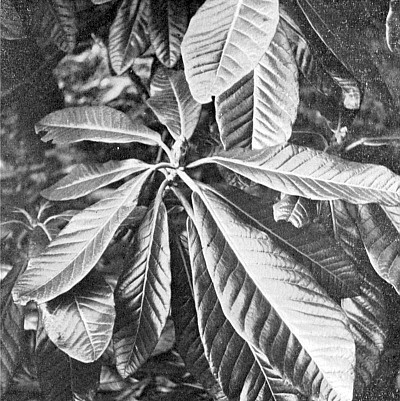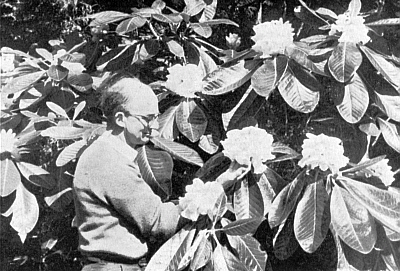QBARS - v26n3 Brodick Castle Gardens
Brodick Castle Gardens
John S. Basford, Isle of Arran, Scotland
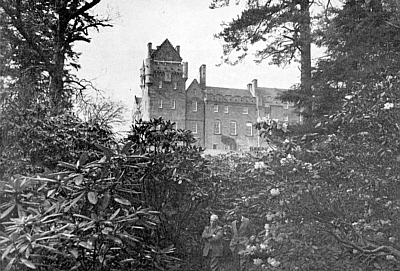
|
|
FIG. 68. Brodick Castle with
R. arizelum
,
arboreum
and campanulatum hybrid. |
The Island of Arran is on roughly the same line of latitude as the Southern part of Hudson's Bay and Southern Alaska, but due to the Gulf Stream and a prevailing Southwest wind the climate is far from similar. We get about 70 inches of rain which falls fairly evenly throughout the year, our drier months being March-June when we often get spells of dry Easterly wind. November and December are our wettest months and with a mild damp October prevent the wood ripening on quite a few tender shrubs that would otherwise grow here. We rarely get frost before December and with luck do not get air frosts after the middle of March. Snow falls very regularly on the hills but only reaches the lower levels on odd occasions, and then does not last for more than a day or so.
Brodick Castle is on a natural promontory on the North side of Brodick Bay facing South. The Vikings first had a port on this site and after the usual assortment of buildings and sackings, the present Castle started to take shape in the Fifteenth Century. It was added to for the Cromwellian garrison and the West wing was built in the middle of the last Century. The garden has been developed since 1710 when the wall round the formal garden was built. We now have grass terraces, lawns and shrubberies round the castle, a formal garden which is bedded out twice a year to give a long lasting and colourful display. The Pond Garden, less formal with several small ponds, large beds of Primulas, Meconopsis and similar plants, also plantings of flowering trees and shrubs including many Rhododendrons and Magnolias. Lastly the Woodland Garden which has been developed since about 1926. Here are more Rhododendrons. Magnolias and Camellias along with Summer flowering trees and shrubs.
I came to Brodick fourteen years ago, when it became a property of the National Trust for Scotland. The first job was to convert what had been a private garden with mainly a Spring and early Summer show into a garden which now has about 30,000 visitors a year, mostly in the summer months. Because we inherited a very good collection of Rhododendron species it was felt that we should increase the Rhododendrons along with related shrubs. Recently we have been gifted the Gigha Collection of Rhododendron Hybrids and many of these plants have now reached flowering size.
The soil is either a sandy or peaty loam which drains easily. In many areas the old red sandstone is showing through but in spite of shallow soil in some areas most things grow vigorously. The many deciduous trees supply a natural mulch every autumn. After new plantings we top dress with manure, leaf mould or composted seaweed for the first couple of years. After this, plants are established and fend for themselves.
With our mild moist climate we are able to grow an extensive range of Rhododendrons. We get some trouble with frost damage to the flower buds of such species as R cubitti , R. rhabdotum , R. chrysodoron and other tender species after a "severe" winter. Incidentally I find the hybrid R. 'Chrysomanicum' far more bud tender than either of its parents R. chrysodoron and R. burmanicum . Many of the alpine species are inclined to make too much growth but we remedy this by planting in full sun on one of our rock outcrops. This, along with a starvation diet, makes most of them flower well. It was some time before I found the right site for R. oldhamii , which kept dying back. I then realized that its hairy leaves did not like drip from overhead trees. An elementary point which I should have avoided in the first place.
I was growing Rhododendrons in the Midlands of England before I came to Arran and was used to rather hard grown plants with flat tops where they produced most of their bloom. Here Rhododendrons remain bushy with flowers right down to ground level even in old age. This is very noticeable in plants of the Grande Series where plants twenty-five feet high flower well all over. These big leaved Rhododendrons do particularly well at Brodick where we have plenty of tall trees and masses of R. ponticum to act as a wind-break. We grow many of these big-leaved species in bays cut in the R. ponticum which under our conditions grows fifteen to eighteen feet high. The first flower of this series is R. giganteum in February. Anybody who is lucky enough to be able to try this giant remember to put it in its permanent home early in life as it produces far more thick roots and less of a root ball than most other Rhododendrons. A move later in life is greatly resented and may even kill it.
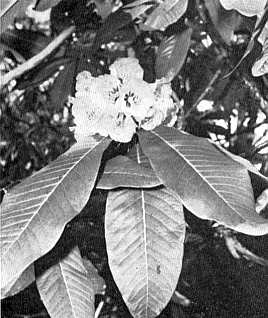
|
| FIG. 69. R. magnificum, F.C.C. 1966. |
It is quickly followed by R. magnificum to which it is closely related - the difference being in the foliage. R. giganteum leaves are fairly broad with a mat green reverse. R. magnificum leaves are longer and narrower with a grey plastered indumentum on the reverse. The flowers are the same shade of fucherine-purple but a good truss of R. magnificum can be nearly twice the size of R. giganteum . Both species are very susceptible to late frost damage as they start into growth early in April but side growths quickly develop after a frosting and except for a twist in the stem, the plants have recovered by mid summer. The bright scarlet bracts that cover the new growths of both species elongate as the buds grow and in April the plants are covered with nine to ten inch long bright scarlet candles.
Next to flower is R. mollyanum at its best a deep pink with up to thirty flowers on a truss. This is one of the hardier members of the series as in spite of flowering in March its new growth does not appear until well into May.
When the seed of R. macabeanum was first being distributed in this country, Brodick unfortunately received seed of the cream form, these resulting plants are about twenty-five feet high and flower regularly. Over the years friends have given us some yellow R. macabeanums and although they are quite good we have yet to flower a deep yellow R. macabeanum .
As I have said elsewhere, who can tell R. praestans from R. coryphaeum ? The flowers are similar, they both have the extension of the leaf margin down the leaf petiole and from a gardeners point of view both stand far more wind without damaging their leaves than other members of the series. The last of this section to flower in early May is R. sidereum . This opens a pale pink and turns a good shade of yellow with age, unlike the rest of the series whose colour is inclined to fade as the blooms age. I understand that R. sidereum may be resistant to some of the root rots that can cause so much trouble in the warmer parts of the U.S.A. It would be interesting to know how it behaves as a root stock for some of the American heat resistant hybrids.
|
||
|
Lastly R. sinogrande . Some of our plants have reached the small tree stage and by the end of April should be a mass of bloom. As so often happens our plant with the best foliage, many leaves over two feet long, has a rather poor truss when it flowers. I find this often happens and think that an interesting class in the specie section of a show could be: Any specie one truss of bloom and one head of foliage of that specie but not necessarily from the same plant shown in separate vases. Before we leave the big leaved fellows a couple of hybrids that are worth growing. R. 'Fortune' which produces very large leaves in a high rainfall area and magnificent trusses of yellow flowers in early May. A hybrid of R. macabeanum x R. sinogrande with enormous broad leaves and very large trusses of yellow flowers with a maroon blotch that open in early April is another favorite.
We grow many of the species in the Maddenii Series and they scent the whole garden in late May and June. I think that some forms of R. ciliatum are the hardiest of the series - I have seen it flower well after 20°F of frost for a prolonged spell during the winter. R. maddenii , R. crassum , R. manipurense and R. megacalyx all grow very strongly, some plants being eighteen to twenty feet high. They make a magnificent display in June with their white and pale pink scented blooms. My favorite from this Series is R. lindleyi of which we grow two forms. One form originally came from the Royal Botanic Gardens in Edinburgh and has five or six mostly white, yellow throated sweetly scented blooms per truss. The other is from the Ludlow and Sherriff collection with up to twelve blooms to the truss on a much bushier plant. Very close to R. lindleyi is R. taggianum - this is a very leggy plant with foliage much broader than R. lindleyi and only three or four blooms to the truss. Luckily both these species set masses of seed which germinates very easily, the resulting seedlings flower in three to four years. We grow quite a few of these leggy members of the Maddenii Series either planted very close together where they quickly form a clump and hold each other up or through other Rhododendrons which I understand from the late Major Sherriff is how they grow in the wild.
Before I leave these tender Rhodies I must mention R. iteophyllum , much hardier than the Royal Horticultural Societies Handbook would have you believe - in fact it flourishes in most Scottish West coast gardens. I feel that with its neat rounded habit it would be a good point to start hybridizing to try and produce a race of dwarf scented hybrids to use as pot or tub plants.
On the table as I write there is a bowl of R. lutescens with flowers a good mid yellow averaging 2¼ inches across. It also has dark copper colored foliage when it is young. We grow two other forms with different sized flowers and a fourth one that should have been consigned to the fire long ago. Of course this is seedling variation and is only to be expected within the specie.
Having made this point on variation I do wish people who collect seed from the wild would add to their collection notes a comparison of their plants to known forms in cultivation. You would then know whether to expect just an interesting plant grown from wild seed or a possible new form of the specie. In the first case I would only want to grow the odd plant to maturity but where there is a good chance of an improved form I would try to grow as many plants as possible to flowering size. Also I wonder how many hybridists using species really do get the best form in cultivation to work with? I feel your Rhododendron Species Foundation should soon be doing great work in this field.
The Triflorum Series are the true shrubs of the Rhododendron family. I feel they fit in easily with other shrubs in a mixed border whereas the large flowered species or hybrids seem out of place and look better to my eyes grown on their own. I long ago came to the conclusion that R. augustinii varies in colour at the slightest excuse be it soil, climate or just plain cussedness. I know the dark blues are tender but I have found a pale blue form with a green eye that is reasonably hardy. A really hardy member of this series is R. yunnanense . I prefer the pure white form with scarlet spots to the pale mauves and dirty whites. It makes a good specimen plant reaching twelve to fourteen feet in height and is excellent for informal hedges which only need an occasional pruning to keep them in shape. We plant R. yunnanense in a single or double row and as the plants grow, anchor the lower shoots with large stones. Many of these shoots take root and help to thicken the hedge.
Now for a Rhododendron I find very attractive but very hard to site, R. orbiculare . Its bright icing sugar pink flowers swear badly if placed with any shade of red or mauve. At Brodick we have one large plant with an even taller plant of R. dalhousiae growing through it, the lime green flowers which open at the same time as R. orbiculare make an ideal combination. I know only a few people can grow R. dalhousiae so maybe the best position for R. orbiculare is as a specimen plant growing in grass or among evergreens where it cannot fight with its neighbors. While in the Fortunei Series a word about its early flowering members: R. praevernum , R. sutchuenense and R. calophytum . I never know how to separate these three and thank goodness it is the botanists job and not mine. They are all good early flowering Rhodies and are fairly frost resistant. R. oreodoxa will give of its best every spring once it reaches flowering size. I wish I could say the same of R. fargesii , some years it is magnificent and at other times it flowers inside the bush making it hardly worth looking at. Incidentally, this is another pair I cannot tell apart very easily.
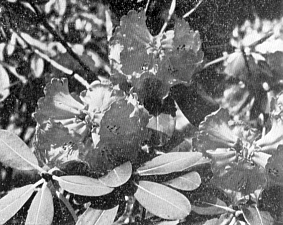
|
|
FIG. 72.
R. meddianum
. From Kingdon-
Ward introduction. Photos courtesy of J. S. Basford |
When I came to Brodick there were quite a few young Rhododendrons grown from seed sent home by the Kingdon-Ward 1953 Expedition growing in a nursery. Our first find was the R. glaucophyllum var. luteiflorum . This is similar in all respects to R. glaucophyllum except that its yellow flowers open at least a month earlier and it is more tender. K.W. 21001 Boothii Series turned out to be R. sulfureum with small deep yellow flowers and I am afraid again rather tender. Our worst plant so far from this collection is R. euchaites with dirty orange flowers more like a bad R. dichroanthum . These have long ago been given dishonorable incineration. A good plant from the K. W. 1950 Expedition is R. meddianum - it has a double ring of bright scarlet flowers far longer than any other R. meddianum I have seen. As with all new forms the next question is how hardy will it be in comparison with others in cultivation.
Anybody who feels that their climate and protection from strong winds would allow them to grow one or two of the larger leaved Rhododendrons should try either R. fictolacteum or R. hodgsonii from the Falconeri Series. At Brodick we are lucky in having a very distinctive plant of the small leaved R. fictolacteum from an early introduction. It has a large truss of white flowers with a port wine blotch. Incidentally I find it one of the worst Rhodies to carry to a show as the petals bruise very easily. The leaves of this plant have a very thick rusty indumentum and the greenish brown new growths are very showy when they appear. I have yet to flower R. hodgsonii at Brodick as when I arrived this specie was not represented in the collection. I have several layers from good forms all growing rapidly but from what I have seen of R. hodgsonii its foliage is its strong point. R. arizelum , R. basilicum and R. coriaceum are all worth trying as even if they do not flower their foliage is very decorative.
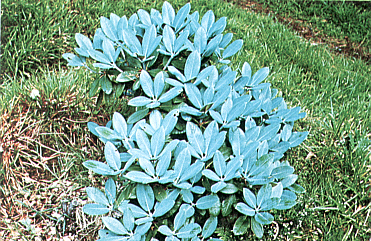
|
|
R. campanulatum
var.
aeruginosum
at Brodick putting on new growth. J. S. Basford photo |
In the garden we have a very large plant of R. lepidostylum at least four feet high and eight feet across. Here I am sure that the foliage especially when young is far better than the flower and if I had time all the flowers would be pulled off. Another good foliage Rhododendron is R. campanulatum var. aeruginosum . We have a plant growing in an old tree stump on the opposite side of the path to the big R. lepidostylum and much to my surprise they show each other off very well.
I think if I had to choose a few species to give a colorful display and to try to interest somebody who knows nothing of Rhododendrons, most of them would come from the Thomsonii Series. Among my fovourites are R. callimorphum that flowers in late May and has deep pink flowers with a large crimson blotch. One plant at Brodick overhangs a mossy rock and this natural nursery has produced dozens of plants, and all that I have grown to flowering size so far have proved to be true to type. R. campylocarpum is worth a place in any garden. I suppose there are bad forms but thank goodness I have not found them as yet. If R. cerasinum could be persuaded to flower on the outside of the bush and not cover its blooms with new growth it would be very showy, but because it does not flower until June it is worth growing. I grow both the crimson and the white and crimson forms and find the plants exactly similar except for flower colour. The deep pink open flowers of R. souliei and the yellow of R. wardii would surely interest any lover of flowering shrubs not to mention a Rhododendron enthusiast. For those who have a larger garden R. thomsonii the name plant of the Series will give of its best once it starts to flower. This is another species which shows very little variation.
I find it very interesting when at shows to compare notes with my friends as to how they cut and carry their exhibits. At Brodick we are about 460 miles from London, 22 of them sea and no Sunday ferry at the time of the year when the Rhododendron Shows are held. We cut half open blooms on a Friday and stand them in deep water in a cool shed overnight. The next morning we move them to our traveling containers, these are large tins varying in size from ½ to 2 gallons filled nearly to the top with sand, then water is added until there is about half an inch over the top of the wet sand. The stems of the show blooms are forced deep into the wet sand and this holds them firmly for their journey. All the containers are loaded into our van, any long stems are supported by extra ties to the side of the van, old sacks etc., are packed between the containers to prevent them slipping should I need to brake suddenly on the journey.
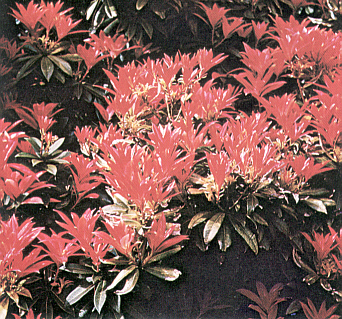
|
|
New growth of
Pieris forrestii
at Brodick Castle.
J. S. Basford photo |
Once loaded I spray overhead with clean water and do my best to keep the blooms damp and cool during the journey. I leave Brodick on the last ferry on a Saturday, break my journey for a day about 100 miles from London and arrive on Monday morning in time to set up for the following day's show. I find foliage carries well if cut in advance, given a good drink, then put a large handful of very wet moss round the cut stem, cover with plastic sheeting and tie firmly. I then pack into wooden boxes well lined with old newspaper and polythene sheeting. The art is to pack really firmly without crushing. It will last like this for several days but should be unpacked and given a long drink overnight before being used for exhibition.
Lastly, unless you are going to have a specialist garden only of interest to specialists it is very important to have other plants than Rhododendrons in your garden. At Brodick we grow along with our Rhododendrons such things as Magnolias, Camellias, Eucryphias, Hydrangeas, Fuchsias, Crinoriums, Eucalyptus, Fuchsias, Crinodendrons, Hoherias, Dicksonias, Cletheras, Cordylines, Pieris and many others. If it is showy or interesting and fits in with our planting scheme we try it. But beware of the more curious than beautiful plants - they are much better grown in other people's gardens.
Brodick Castle and Gardens are a property of the National Trust for Scotland. The Castle is open to visitors from May to September and the Gardens are open all the year round.
John S. Basford
In recognition of his outstanding service to The American Rhododendron Society, an honorary life membership has been awarded to Mr. John S. Basford, Managing Director of Brodick Gardens.
His generous contributions to the Seed Exchange over the past eight years have provided a valuable resource for many fine species not generally available. Additionally, he has supplied cuttings from Brodick's finest species to the Species Foundation. This award is an expression of appreciation from the Membership for his many kindnesses.
